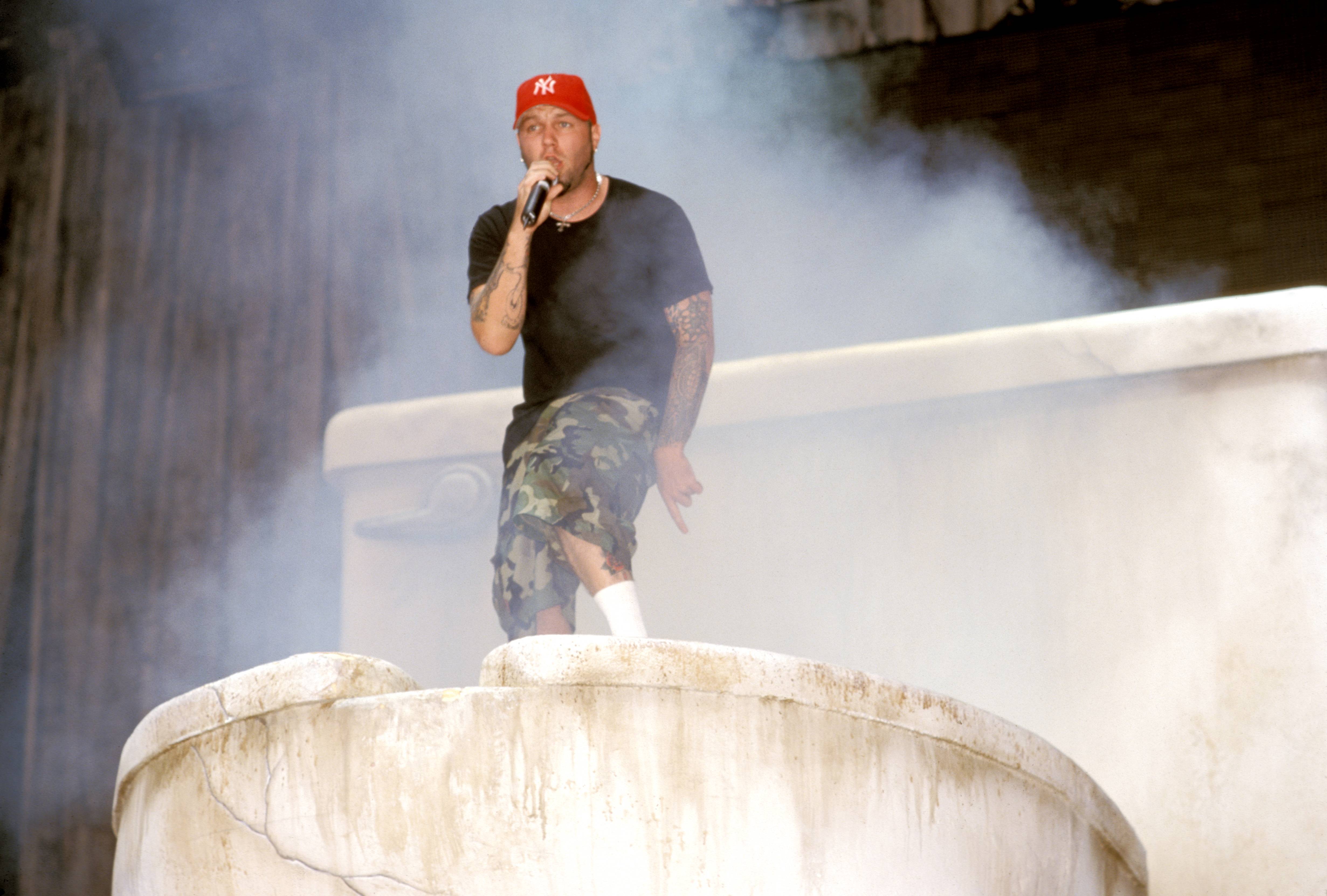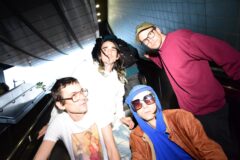This article originally appeared in the August 1999 issue of SPIN.
Fred Durst likes it to the right, with a swivel and bounce. “Yeah, like that, with the knee out. And do that thing with your hips,” he says, then pauses a moment, narrows his gaze, and rubs the furry soul patch on his chin. Five lithe female dancers in clingy black synthetic fibers stare back at him, hanging on his every word.
“Like this?” one asks, doing that thing with her hips.
“Nah, to the right,” he replies. “The right is dope; the left is wack!” The dancer complies, and Durst’s eyes widen. “Yeah, that’s the dope shit!”
The Limp Bizkit frontman is choreographing his “Bizkettes” in a small dance rehearsal space near Times Square in New York City. There’s an old wooden piano in the corner, but the only music in the room comes courtesy of a small boom box playing “Nookie,” the first single from Significant Other, Limp Bizkit’s second rap-metal effort. Tomorrow, he will direct the “Nookie” video, which will include the dancers styled like “little Freds” in khaki Dickies, shell-toe Adidas sneakers, and backward baseball caps; 1,000 rabbit Limp Bizkit fans; and, remarkably enough, an alive-and-kicking Pauly Shore. “Okay, take it from, uh, the top,” Durst says and then starts bouncing and swiveling a bit himself, singing along to the track’s unabashedly stoopid chorus: “I did it all for the nookie / C’mon / The nookie / So you can take that cookie and shove it up your… yeah!”
He spins on his heels to face his entourage—video producer, publicist, assistant, reporter, Pauly Shore. “Yo, this video is going to be the bomb, right?” he asks, scanning their faces for affirmation. “Definitely,” offers the comic formerly known as the Weasel. Durst turns back towards the dancers. “Dope! You guys look great.” His voice gets low and sincere. “You know, you all have great asses. If you didn’t you wouldn’t be in this video… And I don’t mean that in a bad way.”
Meet Fred Durst: Rapper, video director, choreographer, stylist, producer, A&R scout, fledgling filmmaker, graphic designers, major networker, and connoisseur of great asses (in a good way). Armed with ferocious ambition, passable musical talent, and tons of unassuming, regular-dude charm, Limp’s leader has willed himself from provincial Florida to incipient modern-rock stardom. Thing is, he wants so much more. He’s set his sights on being alt-rock’s first Master P—style mogul, one for whom making hit records is just a stepping stone to a multimedia empire. Echoing what Leonardo Da Vinci must have said at least once, he declares, “Yo, people who think I’m just all about one thing are fuckin’ missing the whole fuckin’ point.”
Just what is that “one thing”? Well, during the last two years, Durst and his Jacksonville, Florida-based band—guitarist Wes Borland, bassist Sam Rivers, drummer John Otto, and DJ Lethal (formerly House of Pain)—have helped define alt-rock’s new knucklehead culture in their own baggy-panted image. They’ve incited minor riots, entered stages through a giant toilet bowl, rumbled with radio DJs, and generally played the role of white homeboy enfants terribles. THeir 1997 debut, Three Dollar Bill, Y’all$, is a blisteringly raw montage of bottom-heavy hip-hop beats, squalling guitar, angry screaming, and roughshod rapping about betrayal, the sundry flaws of women, and the sundry virtues of Limp Bizkit. But thanks to the support of good friends Korn, some slick networking, a few lucky breaks, two years of relentless grassroots touring, and a hit remake of George Michael’s “Faith,” Three Dollar Bill, Y’all$ has gone double platinum.
Still, Limp Bizkit have been constantly dissed by critics and Korn fans alike. “People say we’re wannabes or Korn rip-offs, and you just know they’ve never even really listened to what we do,” Durst complains. He says he used to frequent Limp Bizkit chat rooms on the Internet but stopped “because there were too many people talking shit.”
Now, with a new album and a laundry list of upcoming projects, Durst is out for some respect. It’s hard not to root for him, at least a little. An excitable dreamer who comes off much younger than his 28 years, he’s the kind of guy who will suddenly declare that he’s just thought up a “million-dollar idea,” then grab a napkin to take down notes about a “heavy rock meets hardcore rap We Are the World– type record for charity.” He drops the phrase my vision a lot, although he hasn’t quite defined it beyond wanting to be huge. But despite this and his more than slightly mookish image, Durst is extremely down-home friendly (he was raised in the deep South) and obsessed with pleasing his fans, even if it means playing the clown.
“Fred’s like a little teddy bear,” says MTV personality Jesse Camp. “He’s the funniest when he gets in a cranky mood. There’s nothing cuter than that.” Or as Korn’s Jonathan Davis says affectionately, “Fred is such a fuckin’ spazz!”
Maybe, but he is also a slick careerist, one who moved to Los Angeles without his band to better his glad-handing possibilities. He’s immensely attracted to power and celebrity, and aspires to one day schmooze with the best of them. Consider his description of his “close friendship” with head of MTV production Dave Sirulnick, whom he met at an MTV event in Tennessee last year. “Dave needed a ride on our plane down to New Orleans,” says Durst, “and I was like, ‘All right, I’m a salesman here.’ I sat next to him and just started pouring my shit on him. I let him see my vision and how driven I am, and he’s the same way. It’s great.
“Dude, I want to be massive,” Durst continues. “And I think I can do it. I’ve got crazy vision.”
Durst is sitting in a large van idling outside the Sunset Strip Hotel where his bandmates have been staying while Limp Bizkit finish their new record. “All right, yo, listen up,” he says, breaking down the band’s money situation like a B-boy accountant. “We’re going to get, like, three million for publishing. Now, just pretend that half of that is gone for taxes, so that’s 1.5 mil, split five ways. That’s like $300,000 each. Not too fucking bad, huh?”
Durst handles all things financial for Limp Bizkit, and pretty much everything else as well. “My band has life easy,” he says. “But they’re not the kind of people who want too much on their plate. I make sure they get whatever they want, and they don’t want too much.”
At the moment, however, Otto and Rivers don’t want to head off to Magic Mountain, a Six Flags amusement park deep in the heart of the San Fernando Valley. Both guys are hungover—badly—courtesy of an evening carousing at L.A. strip club/rocker hangout Crazy Girls.
“Y’all got fucked up last night?” Durst drawls. He’s answered with a collective groan. The rapper shakes his head and laughs like a bemused older brother. The group’s youngest members, Otto, 21, and Rivers, 22, add some validity to Durst’s assumption that “his band” isn’t interested in much else except playing and buying luxury items with their newfound wealth. They know they’ve hit rock’n’roll jackpot and can’t quite completely believe it. DJ Lethal, 29, the band’s musical secret weapon, is a hired gun who only really connects with the crew when he’s performing. (I’ve kind of been through this before,” he says.) Then there’s Borland, 24, the group’s thoughtful brooder and number-one freak, fond of dresses, bunny suits, and swinging light sabers on stage.
“[Borland] is cool,” says Durst, “but we have different tastes. I just couldn’t deal with him at one point.” Before the band was signed, Durst kicked him out for a while but soon realized that there “wasn’t anyone as good as him who I liked as much. So now he’s the guy who makes us listen to Weez on the tour bus.”
The band’s disparate personalities are conveyed by their answers to the chestnut “Where will you be ten years from now?”
Rivers: In a big ol’ mansion in the Caribbean.”
Otto: “In two mansions: one in the Carribean and one in Hawaii.”
Lethal: “Making beats.”
Borland: “Probably not in the band.”
Durst: “At between 10 and 20 million units sold.”
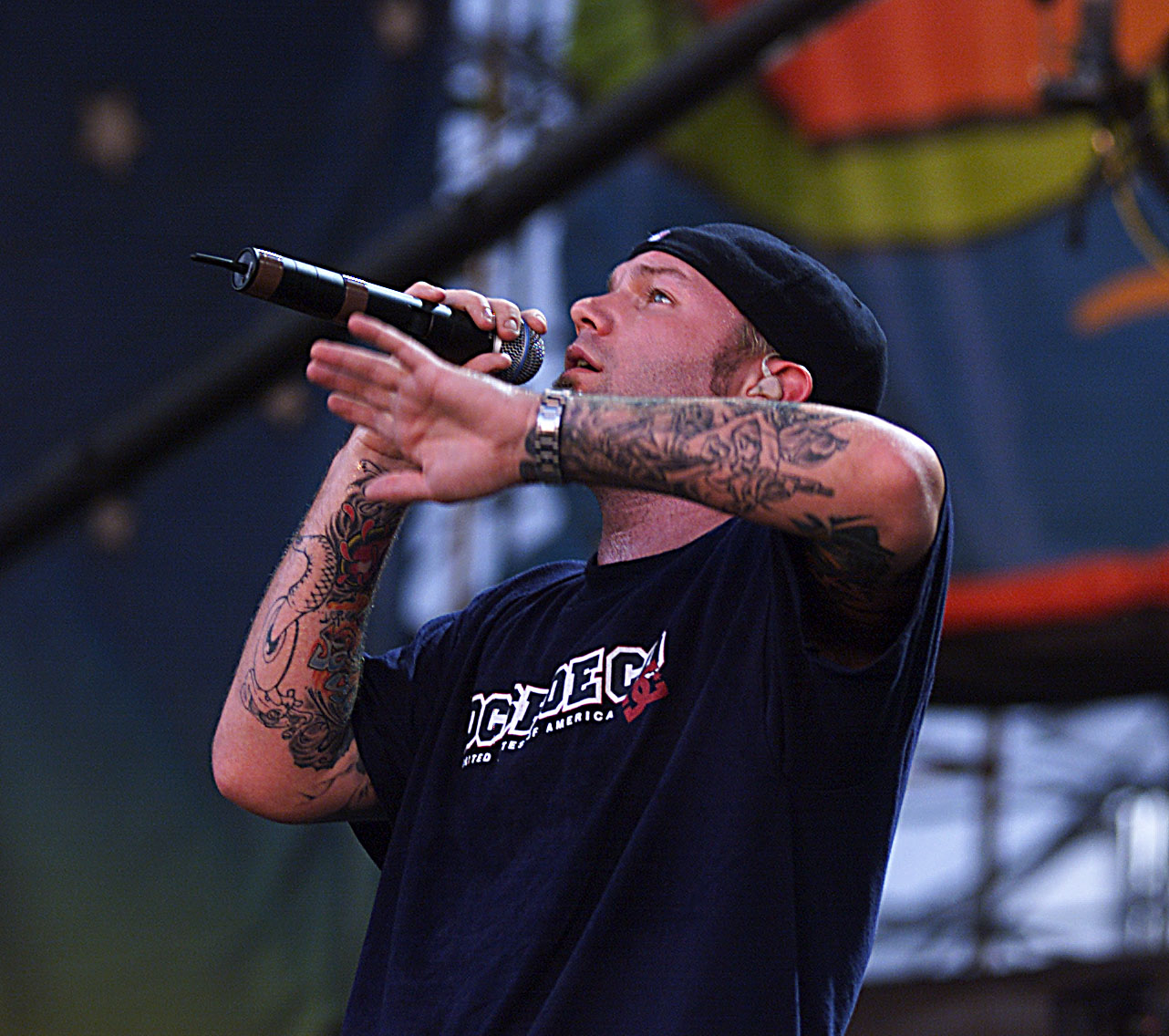
Limp Bizkit was formed in Jacksonville, which some locals call the “biggest small town in America,” an exceedingly conservative, exceedingly Southern, racially mixed city in the swamplands of northeastern Florida. Though Durst was born there, he spent much of his childhood in tiny Gastonia, North Carolina. His father is a retired narcotics officer; his mom a Lutheran Church administrator who used to play Elvis songs at family hootenannies. Durst was the rare Gastonian white boy who lived for graffiti, break dancing, and old-school hip-hop, though he also listened to punk, ska, metal, and an alarming amount of ’80s rock. “Shit, I even liked Flock of Seagulls,” he says.
Durst began writing raps at 14 and says that his love of hip-hop made him an outsider at school. “Gastonia’s got this small-town attitude,” he says, “so I was the so-called n***** lover that all the other kids hated.” After initially scratching their heads about their son’s taste in culture, Durst’s parents became admirably supportive. His dad built a break-dancing studio in the garage, and his mom sewed uniforms for her son’s crew, the Dynamic 3. After high school, Durst served a brief stint in the Navy, got married, had a little girl, who is now eight, and got divorced.
At 20, he moved back to Jacksonville, the ancestral home of Lynyrd Skynyrd, Molly Hatchet, and a crop of ’90s death-metal bands. It’s not exactly fertile hip-hop soil, but the concept for a rap-metal group was firmly entrenched in Durst’s head. In 1994, he was working as a tattoo artist when he saw Rivers play with a local metal outfit and persuaded him to start something new. (“Fred is a hard guy to say no to,” says Rivers.) For a drummer, Rivers suggested his cousin, Otto, who was studying jazz at a performing-arts high school. Guitarist Borland was fronting another local group but quit after seeing Durst onstage. “He was fucking awesome,” he says. “I’d never really seen someone sing-rap like that.” The quartet met DJ Lethal about a year later when they opened up for one of House of Pain’s final shows.
“They did a cover of Paula Abdul’s ‘Straight Up’” Lethal says. “I was like What the fuck? But Fred reminded me of when I first hooked up with Everlast. You could just tell he had that something.” For a band name, they went for the dumbest, weirdest one they could think of. “Somebody said, ‘Gimp Bizkit,’” Rivers says, “then Fred said, ‘Limp Bizkit.’ The next day we were like, ‘That sucks, but fuck it.’”
The band made a demo, which Durst sent to Korn bassist Fieldy, whom he had tattooed during one of Korn’s early tour stops in Jacksonville. “Fieldy tripped on it,” Durst says, “and the next thing you know all these labels were calling.” The band was set to sign with MCA but backed out after attending a meeting in Los Angeles and experiencing what Durst calls “mad bad vibes.” Soon thereafter, Flip/Interscope came calling. Limp Bizkit hooked up with Korn producer Ross Robinson for Three Dollar Bill, Y’All$ and went on the road with Korn. “The rest,” Otto says, “is album sales.”
Not exactly. “It’s not as if Limp were an overnight success,” says Tom Whalley, president of Interscope. “They toured forever.” Limp Bizkit did time with the Warped and Family Values and played a slew of small clubs. “What was most exciting about those earlier shows was that you could tell that there was this new audience out there,” says Whalley, “kids in Adidas who were into both rock and rap—Korn’s audience. We felt that Limp represented something that was going to happen in music on a larger scale.”
Perhaps the ur-’90s label, one that made its name disturbing the gangsta rap of Death Row Records and also brought the world Nine Inch Nails, Marilyn Manson, and Eminem, Interscope has had unparalleled success in tapping the right youth movement at the right time, making it massive by any means necessary. In Limp Bizkit’s case, that meant waking up one morning to find a front page New York Times story reporting that Flip/Interscope had paid a Portland, Oregon, Modern Rock radio station about $5,000 to play their “Counterfeit” single 50 times. The deal was technically legal, but it set off a wave of outrage over what some dubbed the “new payola.”
“The station approached us,” says Whalley. “They explained that it was buying advertising time, not actual station time. We said, ‘Sure, why not?’”
Many cred-concerned bands might have been aghast. Not the Bizkit. “I mean, hey, they ended up playing the shit out of the record,” Durst says. “It wasn’t like we were getting tons of radio play anyway.” In fact, it took the steroid-infused “Faith” cover to pierce the rock-radio bubble, and soon the Durst-directed “Faith” video went into near-constant MTV rotation. “I didn’t really see that incredibly ambitious side of him until he made that video,” says Whalley, adding that he’s been mentoring Durst in the ways of music exec-ness. “We had made one version in conjunction with the movie Very Bad Things, and it didn’t turn out that great. Fred called me up and begged me to let him do it again. It turned out to be a crowning moment for him.”
“The video was great, and I learned a lot,” Durst says. “But, dude, I’ve always been this way.”
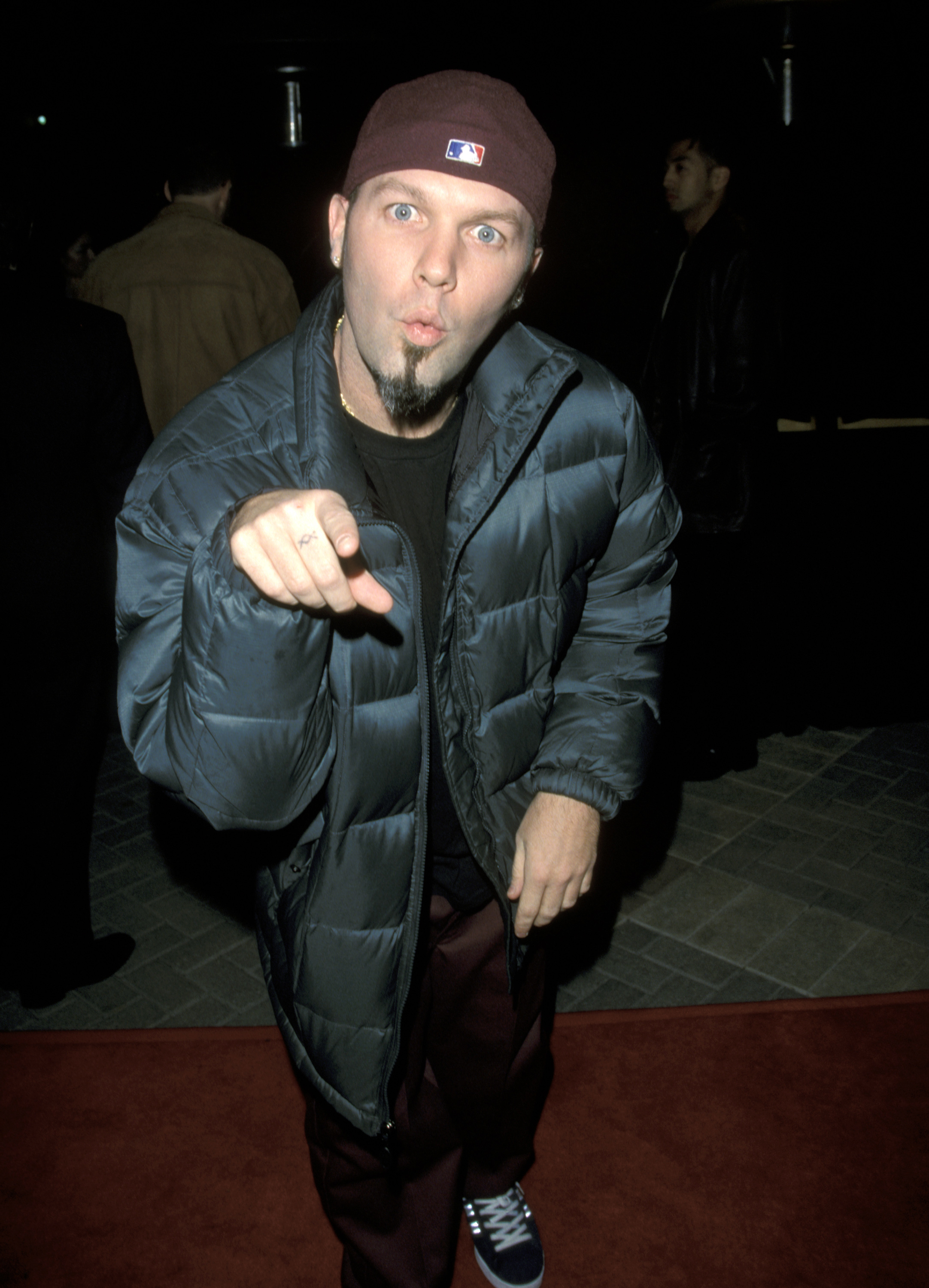
For the ride to Magic Mountain, the band splits into two cars. In the Mercedes are Borland, Durst, and his new girlfriend, a blond, professionally friendly MTV talent executive he met in Jamaica when Limp Bizkit played a spring-break special there. In the van, Otto and Rivers recount tour war stories, like the time the band fired BB guns out of their bus and were approached by an army of Detroit’s finest. Otto was held for carrying a switchblade, but the arresting officer had a sense of humor. “He was like, ‘If you were the drummer from Def Leppard, it would have been all right,’” Otto says.
When everyone reconvenes in front of the park, it’s obvious that it’s not the best day for Limp Bizkit to be at Magic Mountain. It’s Good Friday, and all the teenagers in the Valley have apparently decided to spend their afternoon at the park. Immediately mobbed, the band signs a few autographs and rushes inside.
First on the agenda is the Riddler, a triple-loop roller coaster you ride standing up, but the enormous line to get on is “ridiculous.” “I wish someone would have called to get us hooked up,” Durst complains. But he’s in a good mood nonetheless, frolicking with his often bemused girlfriend (“A lot of Fred’s schtick is just for show; he’s really very sweet,” she says.) He busts out an array of rock and rap lyrics—heavy on the Eminem—while sweetly accommodating a steady stream of mostly female autograph seekers.
Meanwhile, Borland is listing the music he’s been listening to lately: “Dead Can Dance, Tori Amos, Portishead. I like whatever is the most opposite from us. To tell you the truth, if I wasn’t in the band, I don’t know if I’d buy our album.” This prompts Durst to weigh in with what he considers “perfect records”: Pearl Jam’s Ten, Tool’s Aenima, Nirvana’s Nevermind, and Jane’s Addiction’s Nothing’s Shocking.
But what about Limp Bizkit’s own records? “Our first one is like a demo compared to the new one,” says Rivers. “It makes me never want to play the old songs again.”
“[Significant Other] is so much better,” says Durst. “I really believe we made an original, great record.” At the very least, it’s more melodic. The bass is still meant to rattle dental fillings and the guitars are still alpha male, but Durst sings more than he screams, and there are several radio-friendly numbers, including the melancholic, Cure-style power ballad “No Sex.” “Dude, I have no problem with being pop,” Durst says. “Pop means pop-u-lar, which is cool with me.” That said, there are plenty of songs for 15-year-olds to be 15 to. The aptly titled “Break Stuff,” opens with the line, “It’s just one of those days when you don’t want to wake up / Everything is fucked / Everyone sucks.”
Former producer Ross Robinson was replaced by Terry Date (Helmet, Pantera), whom Borland deems more of an engineer. “We really feel like we produced a lot of this ourselves,” he says. DJ Lethal’s touch is apparent in a more organic hip-hop sensibility. “I choose songs to dig into,” he says. “If a track doesn’t need DJing, I’m not going to force it. But even with the straight-rock shit, almost all the drums are breakbeat hip-hop.”
On the album, Durst talks much game about skinning your ass raw and packing a chain saw, but he’s most lyrically obsessed with a certain lying, cheating ex-girlfriend—the same muse that inspired much of the first album. “There aren’t enough records for me to make about her,” Durst says. “She was this sweet, innocent girl I was in love with, and she just turned into this swinging-ass bisexual, fucking my dirtiest friends. We broke up, like, two years ago. She calls now and says she loves me, that she’s done with all that. But I’m hurt, and I kind of can’t get over it.”
The unexpected vulnerability in such love-gone-wrong songs as “Rearranged” is a welcome respite from all the unthinking aggression and bitch-baiting. In many respects this mysterious “she” seems to have become an all-purpose stand-in for Durst’s otherwise unexamined loneliness and rage. Then again, as Durst readily admits, he’s often as melodramatic as he is Top 40 ambitious, and a serious rocker is supposed to brood over a girl gone bad. Dredging up youthful anger and rebellion is one thing, taking it somewhere is another. Simply put, Limp Bizkit have yet to write a truly good song. It’s more than a little ironic when MTV’s 120 Minutes host/special guest Matt Pinfield rants, “We need something with substance, depth, soul!”
Durst takes great pride in his MC abilities, and there are times when he displays a functional flow. But his rhyming can be pedestrian, as showcased on the multi-city name-check “Show Me What You Got” and “N2gether Now,” a duet in which he’s overshadowed by a coasting Method Man. “That [collaboration] was the bomb,” says Durst. “Just me and Method, MC and MC. He was smoking blunts and shit, and there was mad love. I said, ‘If I’m going to do some real hip-hop, then I’m not gonna fuck around.’ I mean, Eminem has Dre. We got Method. That’s some hip-hop cred…”
He’s interrupted by a squealed “Oh…my…God! Fred!!”
Laura Blackburn and Moriel Zeilikowsky, both 16 and both wearing eye glitter and pink pagers, have just noticed Durst. He tells his girlfriend to wait, flashes a thousand-watt smile, and ushers the fan over. “Do you guys know we’ve got a new record coming out?” he asks. “You going to go out and buy it?”
“Yeah.”
“You know, we make music for women like you,” Durst flirts. “You listen to the lyrics. Guys just want to go wild and bust each other up.”
After Durst walks away, Blackburn gushes, “He’s so cute! We thought we saw him backstage at the KROQ Christmas show, and we were like, ‘Fred!’”
“It wasn’t really him, though,” Moriel sighs. “It was Vanilla Ice.”
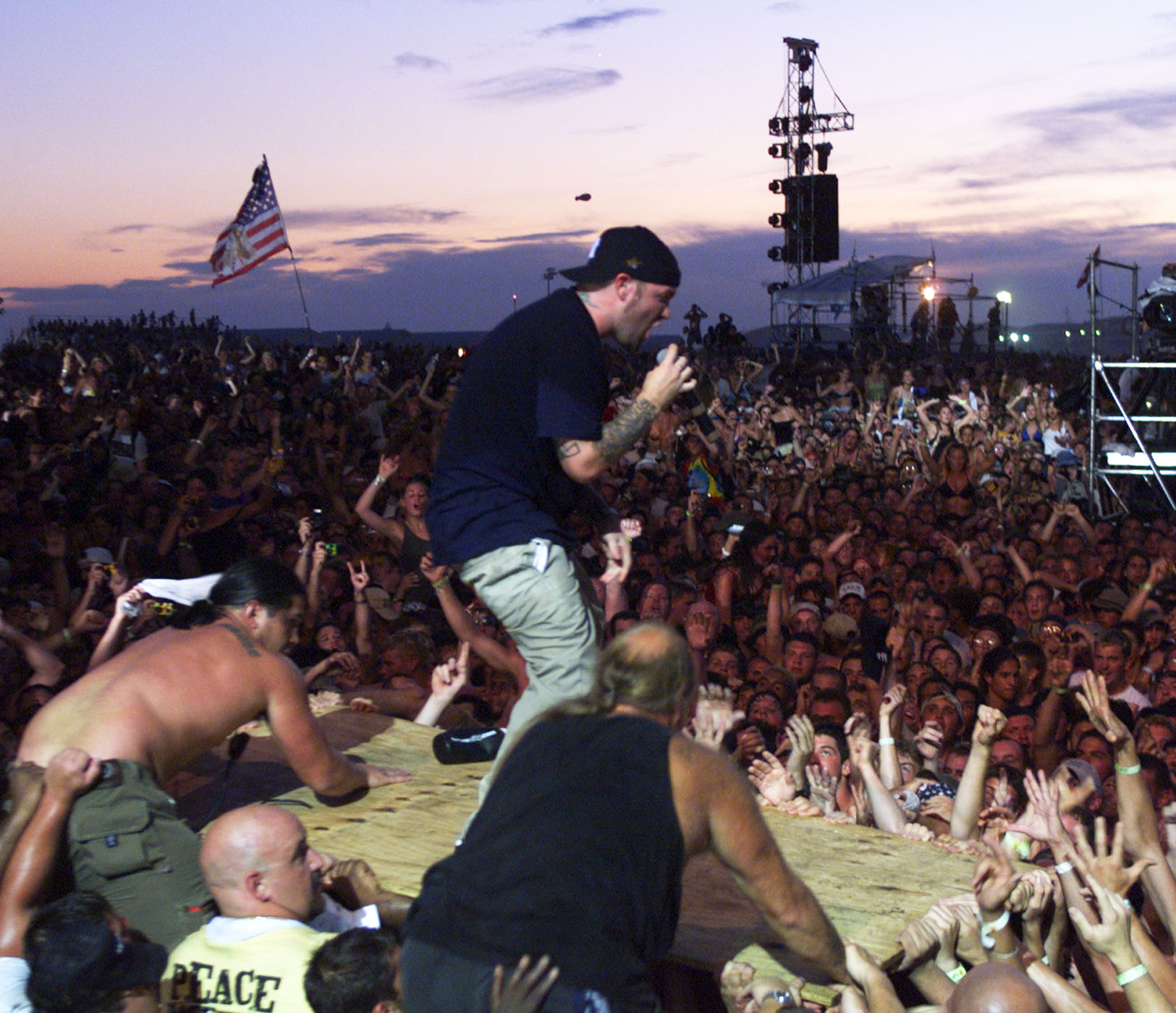
Fred Durst lives in a small, rented prefurnished apartment in a large apartment building on the Sunset Strip, one that looks like it should be populated by slightly hip grandmas. In the living room is a big-screen TV, four separate phones, and a coffee table piled high with books such as Zolar’s Encyclopedia and Dictionary of Dreams, and Breaking Through: Vocal Techniques from Opera to Rock.
On this April afternoon, Durst is sitting at his computer designing the cover art for the new record, with his puppy, Biskit, sitting in his lap. “Dope view, right?” he says, motioning to the large picture window. He’s right—if the air quality was better, you might be able to see the Pacific. Of course, it was only a year ago that Durst told a SPIN reporter, “I’m never going to move to New York or L.A. I’m going to stay here in redneck-ass Jacksonville and hang out with my redneck friends at my redneck cookouts.”
He moved to Los Angeles just a few months later, leaving his band behind. (Lethal grew up in Hollywood, where he still lives.) The Jacksonville stalwarts can’t quite fathom Durst’s decision—“I am Florida,” Otto says. But it’s hard to imagine Durst kicking it at backyard barbeques or cruising the malls anymore. In the six months since he relocated, he’s developed a taste for trendy restaurants and clubs, and has cultivated an eclectic sampling of industry power players and celebrity pals—Tommy Lee (“Dude, Tommy Lee is fucking it out here”), actor Jared Leto, and Goldie Hawn’s actress daughter, Kate Hudson.
“I’m sure everyone in Jacksonville hates me for moving here,” Durst says. “But I can’t be back there without thinking about all the shit I went through with [my ex-girlfriend]. And there’s just more I can do here. In L.A., I can be at dinner and happen to run into a director or producer. That could lead to another album or a movie or someone wanting me to do a sponsorship with Calvin Klein clothes.
“I mean, if I were to try to tell people from home, ‘Dude, last night I was at Goldie Hawn and Kurt Russell’s house kickin’ it with Jim Carrey, and Jim was touching my arm and fucking with me about my tattoos, and Garry Shandling was saying all this funny shit,’ they’d be, like [he mimics a disapproving voice], ‘Oh, dude.’ But I know if Jack Nicholson was walking around the Jacksonville mall, they’d be like, ‘Holy shit!’”
He stops himself; he knows how this sounds. But he’s having such a great time, he seems to be saying—should he have to apologize for that?
Yet on the new record, Durst sings, “I’m lonelier now than I’ve ever been.” I ask if he has a lot of friends in L.A. He takes a while to answer. “No, I guess not,” he says. “And Jacksonville’s worse. So many of my friends have talked shit about me Except my friends in Korn and my management.” He pauses for a while. “I mean, I think my band likes me. They’re probably my best friends.”
So is he happy? “The whole world doesn’t need to know that,” he says a bit touchily. “Just that I have a good personality and that I like to make other people happy.”
The next day, Durst is standing in the rain outside Hollywood’s Palace Theater, along with 1,500 rowdy kids assembled for MTV’s I Wanna Be a VJ Too content. He’s agreed to work the crowd for the cameras for a few hours, and for free. “There are musicians who don’t want to get near the audience, but Fred does,” says MTV’s Sirulnick. “This kind of thing is perfect for him.” True, he gets to kill three birds with one stone: connect with the fans, further ingratiate himself to MTV, and get even more publicity for his upcoming album. Suddenly one particularly eager would-be VJ spots Durst and screams, “Korn!” Durst is unfazed.
He heads inside the theater, over to the red ribbon at the front of the VJ-hopeful queue, where MTV regulars Dave Holmes and Jesse Camp are holding court. Camp turns to Durst and says, “I didn’t know you were coming down here for this, bro.” Finally, after a long wait, the cameras begin to roll. Durst shouts, “I love MTV!” I’m here to rock!” and cuts the ribbon to the roar of the crowd. Now it’s time to rally the troops. He runs up and down the long, soaked line, ordering kids to do jumping jacks and explain why they think they’d be the “dopest VJ ever!” He even convinces onr young woman to doff her top. And as Durst smiles, shakes hands, and clowns for the cameras, kids on line yell, “Ya gotta have faith!” Faith he’s got.

